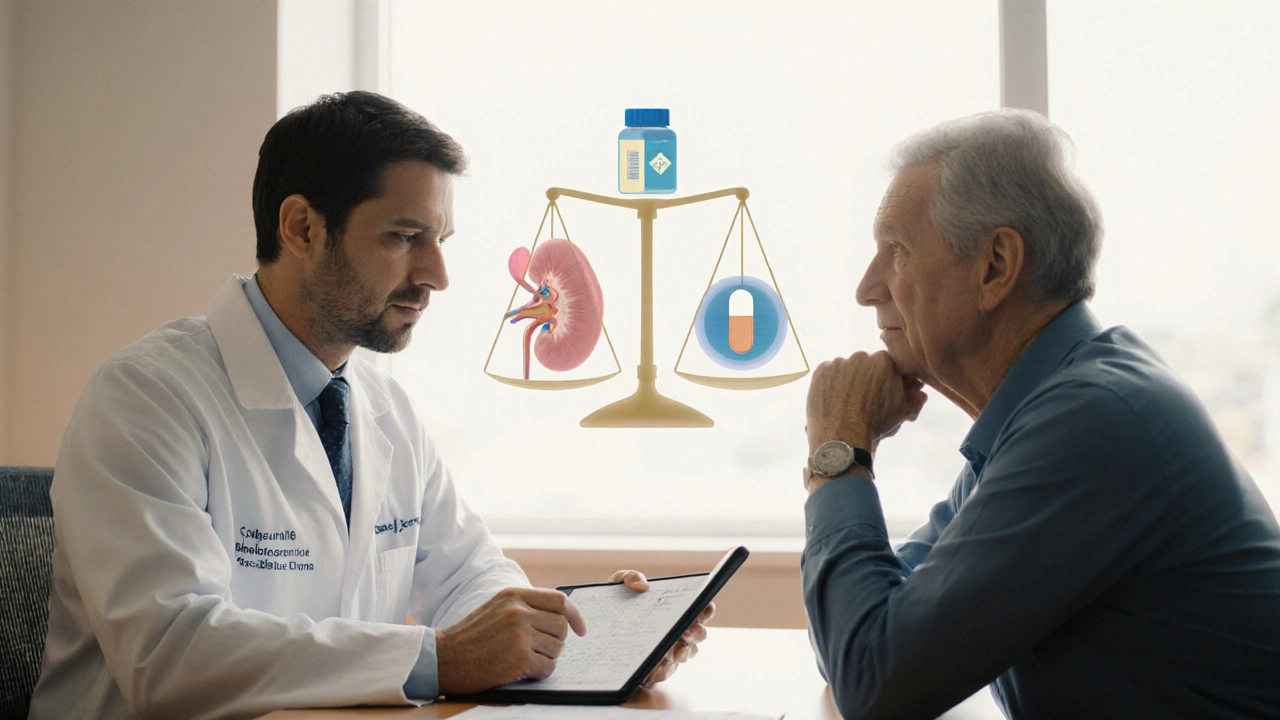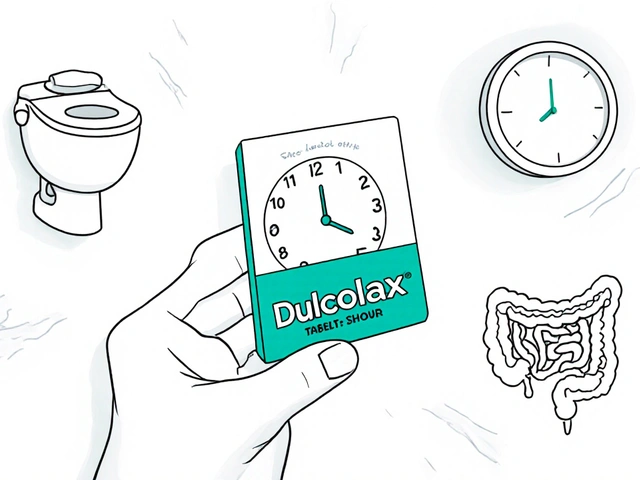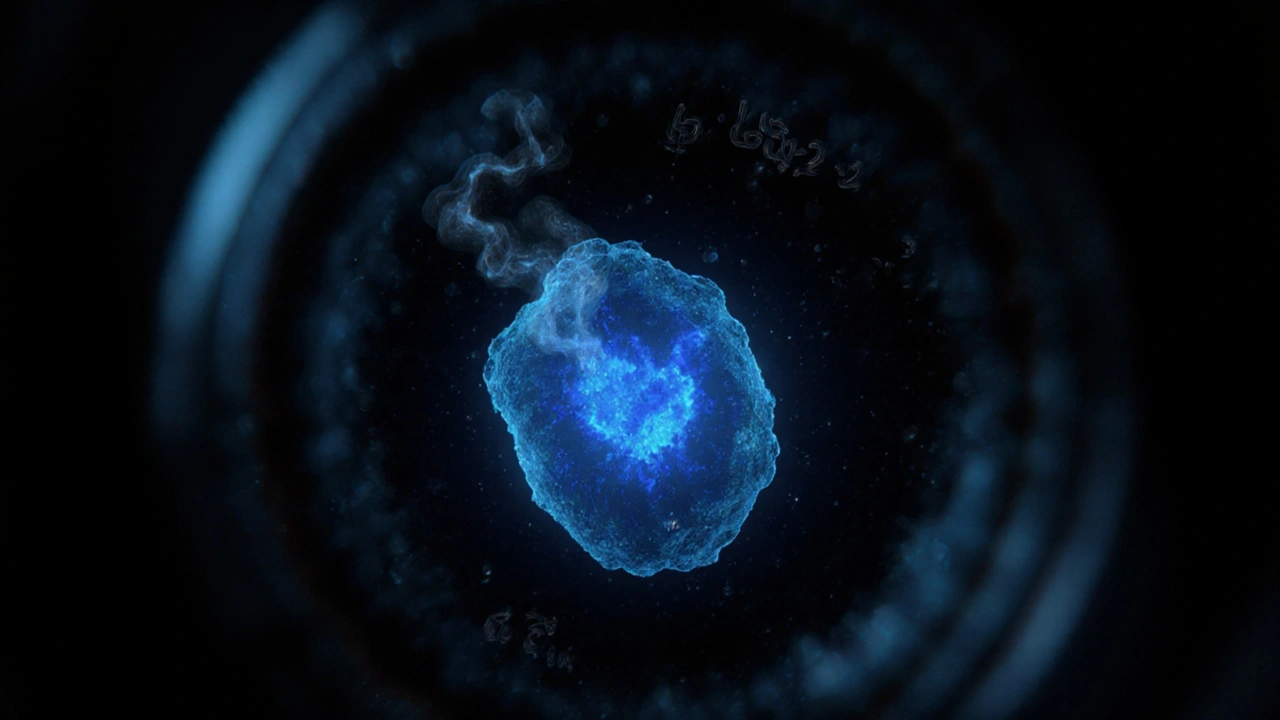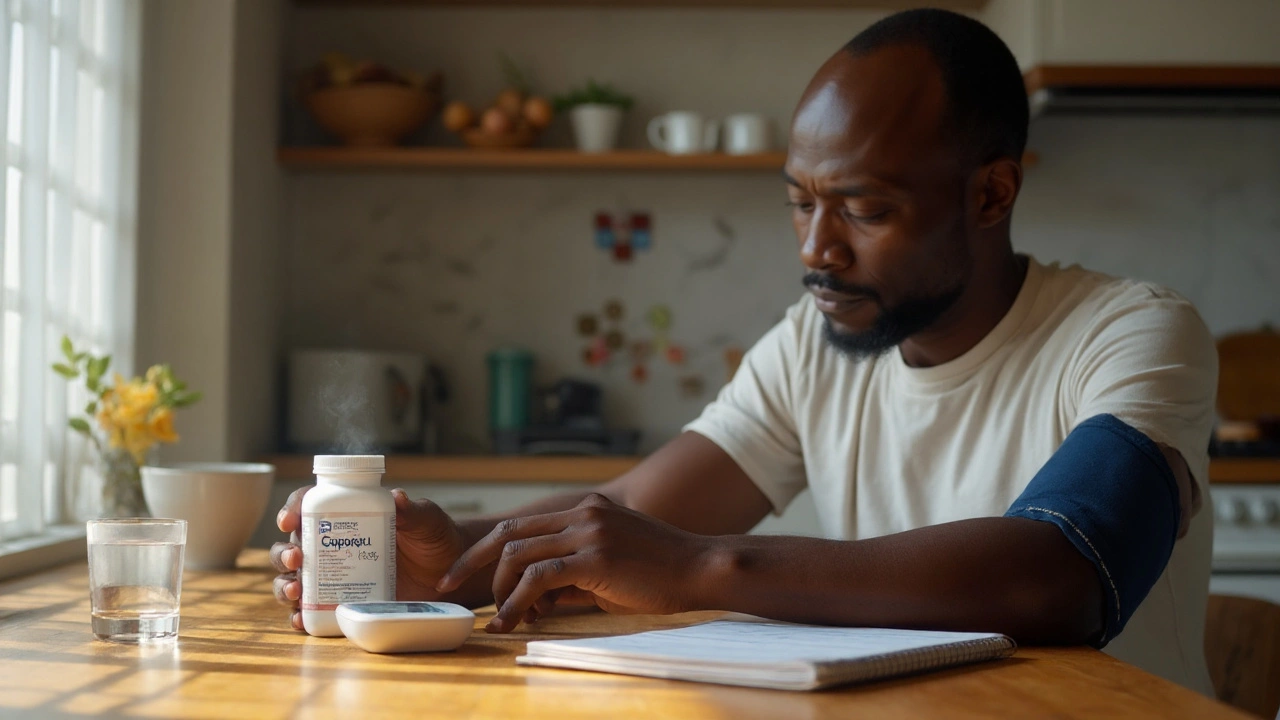Immunosuppressant Selection Tool
Personalized Immunosuppressant Selection
Recommended Immunosuppressant
When doctors need to keep an immune system in check-whether after an organ transplant or for severe autoimmune disease-they often reach for Cyclosporine. But the drug isn’t the only player on the field. This guide breaks down how cyclosporine stacks up against its most common alternatives, helping patients and clinicians decide which medication fits best.
What Cyclosporine is a calcineurin inhibitor that suppresses T‑cell activation, making it a cornerstone for organ‑transplant maintenance and certain skin disorders actually does
Cyclosporine works by binding to cyclophilin, forming a complex that blocks the enzyme calcineurin. Without calcineurin, the transcription factor NFAT stays in the cytoplasm, and crucial cytokines like IL‑2 never get produced. The result? T‑cells stay quiet, and the body’s attack on a new organ or its own tissues is dampened.
Typical dosing for adult kidney‑transplant patients starts around 5mg/kg/day, split into two doses, then adjusted to hit a target blood level of 100‑300ng/mL. Because the drug’s window is narrow, regular blood‑level checks are a must.
Key alternatives you’ll hear about
While cyclosporine has a long track record, several other immunosuppressants offer different mechanisms, side‑effect profiles, or monitoring needs. Below are the big five most often considered alongside cyclosporine.
- Tacrolimus a calcineurin inhibitor similar to cyclosporine but binds to FKBP‑12 instead of cyclophilin
- Mycophenolate mofetil an antimetabolite that blocks guanine nucleotide synthesis, preventing T‑ and B‑cell proliferation
- Azathioprine a purine analog that interferes with DNA synthesis, reducing lymphocyte replication
- Sirolimus an mTOR inhibitor that blocks cell‑cycle progression, especially in T‑cells
- Corticosteroids broad‑acting anti‑inflammatory drugs that suppress multiple immune pathways
How the drugs differ: a side‑by‑side snapshot
| Drug | Primary Mechanism | Typical Indications | Common Dose Range | Key Side Effects | Monitoring Needs |
|---|---|---|---|---|---|
| Cyclosporine | Calcineurin inhibition (cyclophilin‑bound) | Kidney, liver, heart transplants; psoriasis | 3‑6mg/kg/day | Nephrotoxicity, hypertension, hirsutism | Blood trough levels 100‑300ng/mL |
| Tacrolimus | Calcineurin inhibition (FKBP‑12‑bound) | Kidney, liver, lung transplants; atopic dermatitis | 0.1‑0.2mg/kg/day | Nephrotoxicity, neurotoxicity, diabetes | Blood trough levels 5‑15ng/mL |
| Mycophenolate mofetil | Inhibition of IMP dehydrogenase | Kidney & liver transplant maintenance; lupus | 1‑1.5g twice daily | GI upset, leukopenia, increased infection risk | Complete blood count, liver enzymes |
| Azathioprine | Purine analog interfering with DNA synthesis | Kidney transplant; inflammatory bowel disease | 1‑3mg/kg/day | Bone marrow suppression, liver toxicity | CBC, TPMT enzyme activity before start |
| Sirolimus | mTOR inhibition | Kidney transplant; sirolimus‑eluting stents | 2‑5mg/day | Hyperlipidemia, delayed wound healing, anemia | Blood trough levels 5‑15ng/mL, lipid panel |
| Corticosteroids | Broad anti‑inflammatory, genomic and non‑genomic effects | Induction therapy for all transplants; autoimmune flare‑ups | Prednisone 0.5‑1mg/kg/day (tapered) | Weight gain, osteoporosis, glucose intolerance | Blood glucose, bone density (long‑term) |
Decision criteria: what to weigh when picking a drug
Choosing the right immunosuppressant isn’t a one‑size‑fits‑all exercise. Below are the top factors doctors and patients usually balance.
- Efficacy for the specific organ. Kidney transplants historically respond well to cyclosporine, but tacrolimus has shown better long‑term graft survival in some studies. For liver transplants, both work, yet tacrolimus may reduce acute rejection rates.
- Side‑effect tolerance. If a patient already has high blood pressure, cyclosporine’s hypertensive effect could be a deal‑breaker. Conversely, tacrolimus raises diabetes risk, which matters for pre‑diabetic patients.
- Drug‑interaction profile. Cyclosporine and tacrolimus are both metabolized by CYP3A4, so any strong inhibitor (like ketoconazole) can push levels dangerously high. Mycophenolate has fewer CYP interactions, making it a safer add‑on.
- Monitoring logistics. Calcineurin inhibitors require frequent trough‑level draws. If a patient lives far from a lab, an antimetabolite like mycophenolate may be more convenient.
- Cost and insurance coverage. Generic cyclosporine and tacrolimus are affordable in many markets, but brand‑only sirolimus or extended‑release formulations can strain budgets.
Practical guide: when to stick with cyclosporine and when to switch
Below is a quick decision map you can run through with a clinician.
- Scenario A: Newly transplanted kidney, stable blood pressure, no diabetes history - Cyclosporine remains a solid first‑line choice because of its proven record and easy dosing.
- Scenario B: Patient develops hypertension on cyclosporine - consider swapping to Tacrolimus or adding a low‑dose antihypertensive while monitoring trough levels closely.
- Scenario C: Persistent leukopenia despite dose reduction - shift to Mycophenolate mofetil if the patient can tolerate GI upset; check CBC weekly during the transition.
- Scenario D: History of poor wound healing (e.g., after abdominal surgery) - avoid Sirolimus because it delays tissue repair; use it only after wounds have fully closed.
- Scenario E: Patient is a transplant recipient who also needs long‑term steroid taper - maintain a low‑dose Corticosteroid regimen for induction, then wean as tolerated, pairing with whichever calcineurin inhibitor gives the best graft function.
Checklist for clinicians and patients
Print this out or save it on your phone before each clinic visit.
- Current immunosuppressant name and dose.
- Latest therapeutic drug monitoring result (ng/mL).
- Blood pressure, fasting glucose, lipid panel, kidney function (creatinine, eGFR).
- Any new symptoms: tremor, gum hyperplasia, mouth ulcers, hair growth.
- Medication list for potential CYP3A4 interactions (antifungals, macrolide antibiotics, grapefruit).
- Insurance coverage note - brand vs generic, prior‑auth required?
- Planned next‑step: dose adjustment, drug switch, or add‑on therapy.

When to involve a specialist
If any of the following arise, see a transplant pharmacist or a nephrologist experienced in immunosuppression:
- Unexplained rise in serum creatinine.
- Severe hypertension (>160/100 mmHg) despite meds.
- Recurrent infections (CMV, BK virus).
- Persistent metabolic derangements (diabetes, hyperlipidemia) that don’t improve with lifestyle changes.
Future directions: newer agents on the horizon
Research is evaluating belatacept (a costimulation blocker) and gene‑editing approaches that could eventually reduce or eliminate the need for lifelong drugs like cyclosporine. For now, the classic calcineurin inhibitors-cyclic or tacrolimus-remain the workhorses, while antimetabolites and mTOR inhibitors fill niche roles.
Frequently Asked Questions
How quickly does cyclosporine start working after a transplant?
Blood levels rise within a few hours of the first dose, but therapeutic trough concentrations (100‑300ng/mL) usually stabilize after 3‑5 days of consistent dosing.
Can cyclosporine be taken with tacrolimus?
No. Both drugs share the same metabolic pathway (CYP3A4) and boost each other’s levels, dramatically raising toxicity risk. They are used separately, never together.
Why do some patients develop gum overgrowth on cyclosporine?
Cyclosporine stimulates fibroblast activity and collagen production in gingival tissue, leading to hyperplasia. Good oral hygiene and, if severe, dose reduction or switching to tacrolimus can help.
Is it safe to become pregnant while on cyclosporine?
Pregnancy under cyclosporine is considered high‑risk but not forbidden. Studies show a modest increase in low‑birth‑weight infants. Close monitoring of drug levels and fetal growth is essential.
What lifestyle changes can reduce cyclosporine side effects?
Maintain a low‑salt diet to curb hypertension, stay hydrated to protect kidneys, limit grapefruit juice, and keep a regular exercise routine to manage weight and blood sugar.
How often should blood levels be checked?
Initially, twice weekly for the first month, then weekly until stable, and finally every 1‑3 months once the target range is consistently achieved.
Can I switch from cyclosporine to mycophenolate without a wash‑out period?
Yes. Because the mechanisms differ, clinicians often overlap the two for a short transition (3‑5 days) to avoid a gap in immunosuppression, then taper cyclosporine while maintaining mycophenolate doses.






Comments
10 Comments
dany prayogo
Oh, look-another exhaustive tutorial trying to convince us that cyclosporine is the undisputed monarch of immunosuppression, as if the rest of the pharmacopeia were mere peasants!; It waxes poetic about trough levels and nephrotoxicity, then conveniently glosses over the fact that tacrolimus, mycophenolate, and even sirolimus have earned their own grudging respect in the clinic.; One would think that the author has never met a patient whose blood pressure skyrocketed after a modest dose of cyclosporine-yes, hypertension is a gloriously predictable side effect.; And let’s not forget the hirsutism, that delightful excess of facial hair that turns a postoperative male into a bearded Viking overnight; a side effect no one asked for, yet it’s listed under “advantages.”;
The table compares drugs like a bored schoolkid, with columns that read like a grocery list-no nuance, no patient individuality.; Contrary to the author’s bravado, tacrolimus actually offers a tighter therapeutic window, fewer hypertensive spikes, and a comparable graft survival rate in many organ types-surprise!; The claim that cyclosporine is “proven long‑term” is as stale as last year’s flu shot, especially when you consider the surge in diabetes incidence among tacrolimus users, which the article conveniently downplays.; If you enjoy the thrill of endless blood‑level draws, by all means, stay loyal to cyclosporine; otherwise, the modern transplant pharmacist might suggest a regimen that spares you the nightly jittery tremors and the perpetual “is my kidney okay?” anxiety.; Bottom line: the guide is a love letter to legacy drugs, not a balanced decision‑making tool, and anyone reading it should temper the hype with a healthy dose of skepticism.; Moreover, the monitoring schedule outlined in the script assumes a lab within a five‑minute walk, ignoring the reality of rural patients who must drive hours for a trough draw.; In those cases, a switch to mycophenolate or even an mTOR inhibitor can reduce the logistical burden dramatically.; The article’s cautious note about drug interactions reads like a footnote, yet cyclosporine’s notorious CYP3A4 entanglements can turn a simple antifungal prescription into a toxic nightmare.; And while the author mentions cost, they forget that many insurances now favor generic tacrolimus, making it more affordable than a brand‑name cyclosporine formulation.; Finally, the emotional tone of the piece-full of earnest warnings and triumphalist language-betrays a bias that is hard to ignore.; Readers would do well to consult their transplant team, compare real‑world outcomes, and remember that the “right” drug is rarely a one‑size‑fits‑all.; In summary, cyclosporine remains a valuable tool, but not the only one, and the guide’s enthusiasm should be taken with a grain of salt.
Wilda Prima Putri
Got the guide, looks solid. But remember, no one likes endless blood draws. If you’re into hassle‑free meds, maybe look elsewhere.
Edd Dan
I hear what you're saying, and I think both cyclosporine and tacrolimus have their place. In my experiance, patients who can toleratee the blood pressure spikes do fine, but we shouldn't dismiss alternatives. It's all about balancing risk.
Cierra Nakakura
Totally get the hassle 😅! If you want something easier, mycophenolate can be a game‑changer. Just remember to keep an eye on the gut side effects 🧐.
Sharif Ahmed
The pharmacologic tapestry woven within the realm of calcineurin inhibition is a symphony of molecular choreography, wherein cyclosporine occupies but a single, albeit resonant, motif.
Charlie Crabtree
Well said! 🎭 Let’s not forget that patient choice is the real conductor of this orchestra. Keep the conversation alive!
Arjun Santhosh
Nice breakdown, tho i think the real world stuff is a bit more messy. cost and access matter a lot.
Stephanie Jones
One could argue that the chaos you mention is merely the universe's reminder that medicine is not a neat spreadsheet, yet we still strive for clarity.
Nathan Hamer
In the grand theater of immunosuppression, each drug plays its part like actors on a stage, each with a script written in cells and enzymes!; Yet we, the audience, often forget that the spotlight is shared-Cyclosporine, Tacrolimus, Mycophenolate-all yearning for acknowledgement!; Let us applaud the nuance, not just the headline acts! 😊
Jaime Torres
Sounds good.
Write a comment